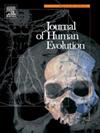伊斯帕尼奥拉岛特有灵长类动物 Antillothrix bernensis 的颅颌面变异
IF 3.1
1区 地球科学
Q1 ANTHROPOLOGY
引用次数: 0
摘要
在这里,我们描述了来自伊斯帕尼奥拉岛的更新世-全新世灵长类动物 Antillothrix bernensis 的新化石材料。目前,来自几个古生物资源丰富的洞穴系统的 7 个颅骨、5 个下颌骨和数十个颅后构件代表了这一类群。本文收录的五具成年颅骨具有相似的整体轮廓以及特殊的特征,例如颅盖上有一个很深的凹陷。Antillothrix的完整前牙现在可以首次描述了;短犬齿冠的尖底尺寸与缇猴相当,但新的颅骨和下颌骨缺乏现生栉水母类的特化高冠门齿。不过,它们的上颌外侧门齿和犬齿之间有一个间隙,这在以前已知的颅骨中是没有的。新的下颌骨后部加深,下颌横突内侧拐弯,与一些蝮蛇科动物相同,但也与 Xenothrix 相同,P4/M1 下的颌骨明显垂直变窄,这在现生类群中没有发现。其中两个标本(一个颅骨和一个下颌骨不吻合)显示先天性无第三臼齿--这在现存的非胼胝类群中十分罕见。在整个 Antillothrix 样本中,估计体重的范围约为 1 千克(从 2.4 千克到 3.4 千克),颅内容积的范围约为 5 立方厘米(从 40 立方厘米到 45 立方厘米)。随着新标本范围的扩大,Antillothrix 不再被描述为脑体积小于其体型预期的类群。无论是脑部大小还是体型大小的范围都没有大到足以表明有很大程度的性二型,也没有必要将样本分为雌雄个体。鉴于这一点,以及所有存在犬齿的标本犬齿大小相似,该样本与形态多变但单态的物种一致。本文章由计算机程序翻译,如有差异,请以英文原文为准。
Craniomandibular variation in the endemic Hispaniolan primate, Antillothrix bernensis
Here we describe new fossil material of Antillothrix bernensis, a Pleistocene-Holocene primate taxon from Hispaniola. It is now represented by seven crania, five mandibles, and dozens of postcranial elements from several paleontologically rich cave systems. The five adult crania included here share a similar overall profile as well as specific features such as a deep depression at the glabella. The complete anterior dentition of Antillothrix can now be described for the first time; short canine crowns, in the apicobasal dimension, compare well with titi monkeys, but the new crania and mandibles lack the specialized tall-crowned incisors of the extant pitheciids. They do, however, have a diastema between the lateral maxillary incisors and canines, a feature not present in the previously known crania. The new mandibles deepen posteriorly and have a medial inflection of the mandibular ramus, as in some pitheciids, but also share with Xenothrix a significant vertical narrowing of the corpus under P4/M1 not observed among extant taxa. Two of the specimens, a cranium and a mandible that do not fit together, exhibit congenitally absent third molars—a rarity among extant, noncallitrichine taxa. There is an approximately 1-kg range in the estimated body mass among the full Antillothrix sample (from 2.4 to 3.4 kg), as well as a range of approximately 5 cm3 of endocranial volume (from 40 to 45 cm3). With these extended ranges from the new specimens, Antillothrix can no longer be described as a taxon with a brain size smaller than that expected for its body size. Neither of these ranges in the brain size or body size is large enough to indicate a substantial level of sexual dimorphism or to necessitate separating the sample into male and female individuals. Given this, and the similar canine sizes for all specimens where they are present, the sample is consistent with a morphologically variable but monomorphic species.
求助全文
通过发布文献求助,成功后即可免费获取论文全文。
去求助
来源期刊

Journal of Human Evolution
生物-进化生物学
CiteScore
6.30
自引率
15.60%
发文量
104
审稿时长
3 months
期刊介绍:
The Journal of Human Evolution concentrates on publishing the highest quality papers covering all aspects of human evolution. The central focus is aimed jointly at paleoanthropological work, covering human and primate fossils, and at comparative studies of living species, including both morphological and molecular evidence. These include descriptions of new discoveries, interpretative analyses of new and previously described material, and assessments of the phylogeny and paleobiology of primate species. Submissions should address issues and questions of broad interest in paleoanthropology.
 求助内容:
求助内容: 应助结果提醒方式:
应助结果提醒方式:


